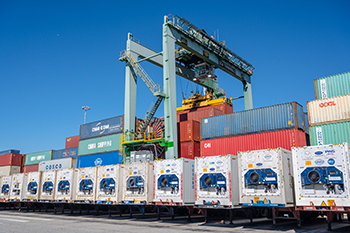SSA Marine is now operating the first of nine electric container yard cranes at the Port of Long Beach's Pier J, marking a significant milestone in a goal to transition to zero emissions terminal equipment by 2030.
The demonstration of the electric rubber tired gantry cranes is part of the Zero-Emissions Terminal Equipment Transition Project, which is funded in large part by a $9.7 million California Energy Commission grant. The Port, the CEC and Southern California Edison are partnering on the project to bring 25 vehicles that are zero- or near-zero emissions to three of the Port's marine terminals and logistics truck provider Total Transportation Services Inc. to test their performance in a real-world setting.

“The future of the industry is zero emissions,” said Long Beach Harbor Commission President Frank Colonna. “The Port of Long Beach will continue to generate economic opportunity as we show that jobs and environmental sustainability can work together.”
“SSA Terminals is proud to partner with the Port to achieve our shared goal of implementing zero-emission cargo handling equipment,” said SSA Superintendent Scott Hainlen, the project coordinator. “We look forward to continuing this partnership with the Port as we explore all options to help do our part to continue to reduce our carbon footprint in Long Beach.”
In 2017, the ports of Long Beach and Los Angeles approved an update to their Clean Air Action Plan, setting a goal of transitioning all terminal equipment to zero emissions by 2030.









